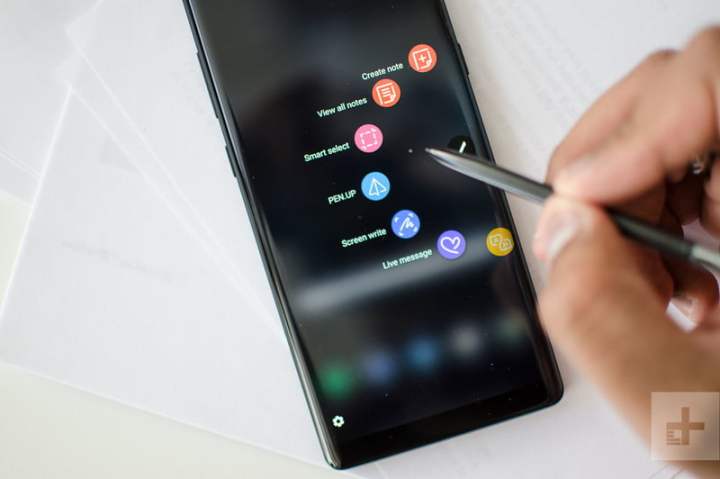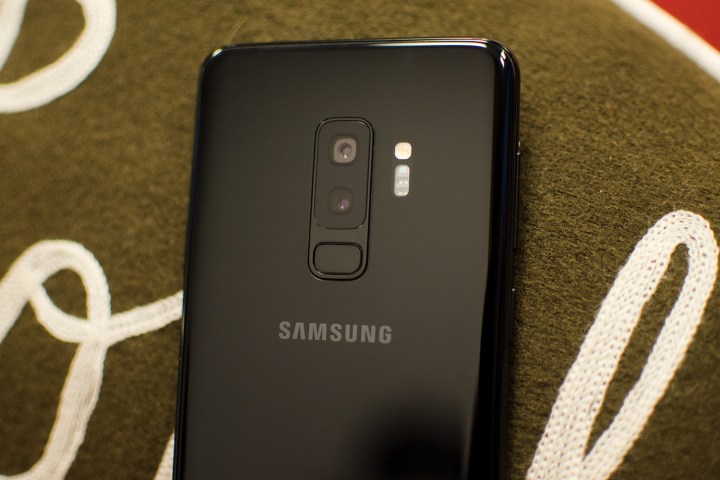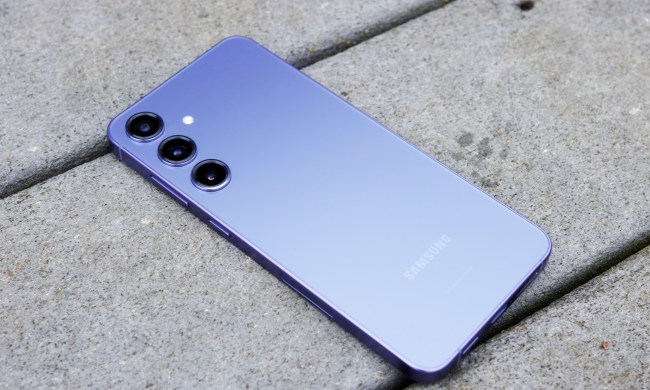If you’re shopping for a powerful phone with a large screen, then Samsung’s heavyweights need to be on your radar. The Samsung Galaxy Note 8 is the biggest phone the South Korean manufacturer offers, but the leaner, newer Galaxy S9 Plus has some important advantages over its opponent. Join us for a spec showdown as these two titans go head-to-head, and find out which one you should buy.
Specs
| Samsung Galaxy S9 Plus | Samsung Galaxy Note 8 | |
| Size | 158.1 x 73.8 x 8.5 mm (6.22 x 2.91 x 0.33 inches) | 162.5 x 74.8 x 8.6 mm (6.40 x 2.94 x 0.34 inches) |
| Weight | 189 grams (6.67 ounces) | 195 grams (6.88 ounces) |
| Screen Size | 6.2-inch AMOLED display | 6.3-inch AMOLED display |
| Screen Resolution | 2,960 x 1,440 pixels (529 pixels-per-inch) | 2,960 x 1,440 pixels (521 pixels-per-inch) |
| Operating System | Samsung Experience 9 (over Android 8.0 Oreo) | Samsung Experience (over Android 7.1.1 Nougat upgradable to 8.0 Oreo) |
| Storage Space | 64GB | 64GB, 128GB, 256GB |
| MicroSD Card Slot | Yes, up to 400GB | Yes, up to 256GB |
| Tap To Pay Services | Samsung Pay, Android Pay | Samsung Pay, Android Pay |
| Processor | Qualcomm Snapdragon 845 | Qualcomm Snapdragon 835 |
| RAM | 6GB | 6GB |
| Camera | Dual sensor 12MP rear, 8MP front | Dual sensor 12MP rear, 8MP front |
| Video | 2,160p at 30 frames per second, 1,080p at 240 fps, 720p at 960 fps | 2,160p at 30 frames per second, 1,080p at 60 fps, 720p at 240 fps |
| Bluetooth Version | Bluetooth 5.0 | Bluetooth 5.0 |
| Ports | 3.5mm headphone jack, USB-Type C | 3.5mm headphone jack, USB-Type C |
| Fingerprint sensor | Yes | Yes |
| Water resistance | IP68 | IP68 |
| Battery | 3,500mAh | 3,300mAh |
| App Marketplace | Google Play Store | Google Play Store |
| Network support | T-Mobile, AT&T, Verizon, Sprint | T-Mobile, AT&T, Verizon, Sprint |
| Colors | Midnight Black, Coral Blue, Titanium Gray, Lilac Purple | Midnight Black, Maple Gold, Orchid Gray, Deep Sea Blue |
| Price | $840 | $950 |
| Buy From | Samsung, Amazon, Target | Samsung, Amazon, Target |
| Review Score | 4.5 out of 5 stars | 4 out of 5 stars |
Performance, battery life, and charging
The S9 Plus comes with Qualcomm’s latest Snapdragon 845 processor, whereas the Note 8 has last year’s Snapdragon 835. The newer processor is faster, more power efficient, and enables a handful of other tricks. Since both phones have 6GB of RAM, we can unequivocally say that the S9 Plus is the better performer.
We also find a slightly larger 3,500mAh battery inside the S9 Plus, compared to the 3,300mAh battery in the Note 8, though weirdly we’ve found the Note 8 to have slightly better battery life in our testing so far. Both phones support wireless charging and fast charging at Quick Charge 2.0 speeds — expect a full charge to take around 90 minutes, and you can get 40 percent or more in half an hour.
Winner: Samsung Galaxy S9 Plus
Design and durability

Samsung’s design language is pretty consistent, so these phones sport very similar screens with curved edges and thin bezels top and bottom. The S9 Plus is definitely more curved than the Note 8, but there isn’t a big difference. When you turn them over, you’ll find that the fingerprint sensor placement on the Galaxy S9 Plus is below the vertically stacked dual camera module, whereas the Note 8 has a horizontal dual camera with the fingerprint sensor at the side. The S9 Plus positioning is much better and makes it far easier to find and use without looking and without smudging your camera lenses. The S9 Plus is also slightly smaller and lighter, which is a good thing for such a big phone.
The S9 Plus also scores points for the stereo speakers, which the Note 8 lacks. There’s no separating them in the durability stakes as both are IP68 rated and equally likely to break if dropped.
Winner: Samsung Galaxy S9 Plus
Display
It’s tough to separate them here, because both phones boast Samsung’s excellent AMOLED screens. The Note 8 has a slightly larger 6.3-inch display, compared to the 6.2-inch display in the S9 Plus. Since both phones have the same resolution, the S9 Plus has a fractionally higher pixel density. In the real world, it’s virtually impossible to tell them apart.
Winner: Tie
Camera
Samsung first made the jump to a dual lens camera with the Note 8, which pairs two 12-megapixel sensors, one with an f/1.7 aperture and one with an f/2.4 aperture. That combination allows it to zoom in without loss of detail, as well as capture some great bokeh shots with sharp subjects and a blurred background. Samsung reimagined the camera in the S9 Plus, so while it sports the same dual lens setup, the first 12-megapixel sensor has a variable aperture that can switch between f/1.5 and f/2.4. The larger f/1.5 aperture enables the S9 Plus to take in more light, so night shots or shots in darker indoor environments turn out much better than they do on the Note 8.
If you’re into shooting video, the S9 Plus is also capable of super slow motion, capturing 720p footage at 960 frames per second. The S9 Plus can also shoot in 1080p at up to 240 fps, while the Note 8 is limited to 60 fps for 1080p or 240 fps for 720p. The front-facing cameras are identical, but the phenomenal low-light performance and slow motion support are enough for the S9 Plus to take this round.
Winner: Samsung Galaxy S9 Plus
Software and updates
The Galaxy Note 8 ships with Android 7.1.1 Nougat and Samsung’s Experience user interface over the top. It is due to get an update to Android 8.0 Oreo in the very near future. The Galaxy S9 Plus ships with Android 8.0 Oreo and Samsung Experience 9. The Note 8 has a few S-Pen specific software options, but the S9 Plus has a newer version of Android and Samsung’s latest UI with all the latest tricks, such as the ability to switch to landscape view, even on the home screen, and have the display change orientation.
As a slightly newer device, we also expect the S9 Plus to get future software updates faster and for slightly longer than the Note 8.
Winner: Samsung Galaxy S9 Plus
Special features

When it comes to adding value with special features, you can count on Samsung. Both these phones have A.I. assistant Bixby onboard and they can both pull duty as desktop computer replacements thanks to the Dex Station. Only the Note 8 has the S-Pen stylus, which proves very handy if you like to take notes or even sketch on your phone. Samsung has worked on some clever integrations with the software to make the S-Pen useful. Most people don’t use a stylus with their phones, but if you do like to, then this is a big win for the Note 8.
Winner: Samsung Galaxy Note 8
Price
All the big releases from Samsung, including the Note 8 and S9 Plus, are widely available to buy unlocked from various retailers or direct from Samsung, or you can get them from all the major carriers on contract deals if you prefer. The Note 8 is currently priced at $950 direct from Samsung, which is $110 more than the S9 Plus at $840. Samsung frequently runs promotions, and you might find trade-in deals if you have an old Galaxy to sell, so do your homework — our Note 8 buying guide or our S9 Plus buying guide will help you get the best deal.
Winner: Samsung Galaxy S9 Plus
Overall winner: Samsung Galaxy S9 Plus
There’s no doubting the decision here, the Galaxy S9 Plus is a better phone at a lower price. If the S-Pen is a killer feature for you, then you might opt for the Note 8, but everyone else should pick up the S9 Plus — it’s faster, has a more refined design, and sports an improved camera, newer software, and a bigger battery. Owners of the Note 8 pondering an upgrade have a tougher decision to make — jump to the S9 Plus or wait a few months for the Note 9. We don’t think you’ll notice a big difference switching to the S9 Plus from the Note 8, so it might be better to wait. The S9 Plus is certainly Samsung’s current cream of the crop, but they’re both great phones.






